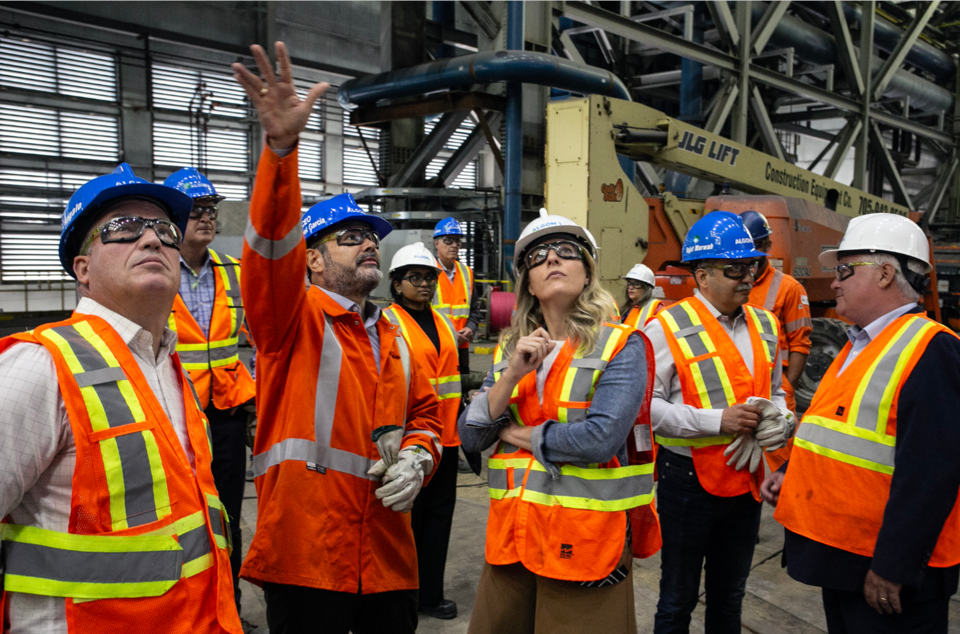Algoma Steel management is counting on Ottawa and the Carney government to begin rolling out its Building Canada Agenda in a timely fashion.
The company is marking a pivotal time in 2025 in shifting from expensive and dirty blast furnace steelmaking to cleaner, greener and more productive electric arc furnace production. The first of two units entered production earlier this month.
But there are also serious considerations to undertake at the Sault Ste. Marie steel company when it comes to drumming up new Canadian customers given the chaotic uncertainly associated with the Trump administration’s newly installed 50 per cent tariff on Canadian imports of steel and aluminum.
Algoma CEO Michael Garcia hinted in a July 30 webcall with industry analysts that there might be hard decisions coming later this year on whether the company can continue to sustainably supply its long-time American customers.
North of 50 per cent of Algoma’s production heads south of the border to fulfill contractual supply agreements.
The company’s $110-million second quarter loss this week and the $74.6 million paid out in tariffs so far this year only figures to worsen should tariffs stay where they are.
As to how long Algoma can continue to burn through capital to service that American customer base, Garcia said if the tariff landscape remains the same for the rest of this year, that’ll be a topic of discussion in their annual fourth quarter contract meetings.
“It’s something we need to be thoughtful about and, frankly, our customers need to be thoughtful about as well.”
The Canadian government wants to source domestic steel for federal projects like shipbuilding and infrastructure, specifically in the energy field. But foreign-imported and dumped steel in Canada remains a chronic problem.
Garcia said, up until 12 months ago, 66 per cent of Canadian steel consumption came from offshore producers, practically unheard of in the top 20 leading economies in the world. All steel-producing countries, large and small, supply a majority of domestic needs with its own production, he said.
Garcia said they’ve strongly advocated to the feds to install more measures to safeguard the Canadian industry. Ottawa has listened and taken steps to do so, but there's work to be done.
“The way the Canadian market moves and transitions ... will be a big part of the scenarios that we prepare ourselves for.”
Canada’s sheet market and the pricing remains weak and oversupplied. But Algoma’s ace in the hole is its increased plate production, emerging from its modern plate mill.
Algoma has been able to build its domestic market share in plate to more than 40 per cent. Garcia expects that to grow due to the many Build Canada Strong projects being advanced by the Carney government.
While it's not yet showing up in the order book, Garcia said Algoma is positioning itself to be ready when projects are greenlit.
Algoma recently signed a memorandum of understanding with Vancouver shipbuilder Seaspan to be part of the shipbuilding supply chain network and aims to do the same on the defence side and with energy projects.
“The groundwork is being laid, so that will be a driver for this volume in the future,” said Garcia.
Exporting steel abroad to European and other global customers remains difficult, given Algoma’s geographical location.
“There just aren’t those opportunities right now,” said Garcia, who cast doubt on whether those avenues will ever emerge.
In the meantime, to withstand the tariff hit, Garcia said Algoma is in “very active” discussions with the federal government to secure up to $500 million in relief through the Large Enterprise Tariff Loan program. He provided no details on those discussions, except to say talks have progressed.
The company entertained federal Industry Minister Melanie Joly this week, taking her on a tour of the new furnace facility and other site upgrades.




